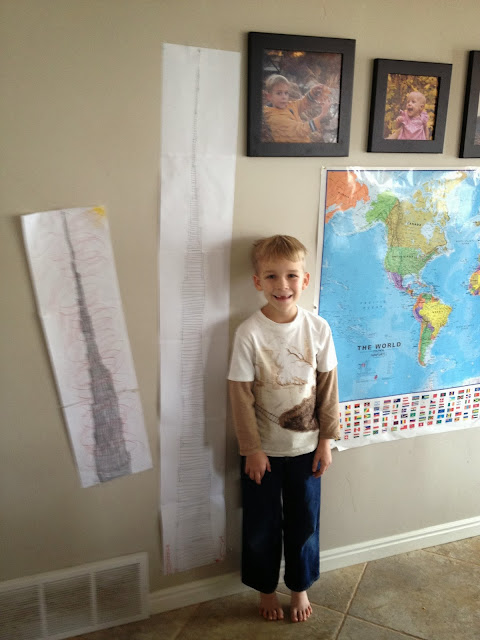Geodesic Domes are cool. They were kind of claimed by hippies for awhile, but they're cool anyway. :) We loved learning about Buckminster Fuller and all his quirky ways (such as referring to downstairs as "instairs" and upstairs as "outstairs," to more accurately reflect our position in 3D space---awesome).
To understand geodesic domes, I first turned, as I often do, to my brother Karl. He told me what a "geodesic" is---it's the arc of a Great Circle that divides a sphere into hemispheres. But, I asked him, how is a geodesic dome made up of great circles when it looks like it's made of a bunch of triangles? He suggested I dip string in sugar water to make it stiff, and then wrap it around a balloon in several great circles. Then pop the balloon to see how it forms triangles when flattened.
Hmm. That didn't work. But we got the point anyway---the triangles form from the intersection of many great circles around a sphere!
We already know how strong triangles are, and when they are combined to approximate a sphere or hemisphere, they become stronger still! They are also lightweight and have the lowest ratio of building material to area covered of any structure. You can see why ol' Bucky (I'm not being disrespectful; he preferred to be called that!) liked them.
There's a really interesting discussion of perhaps the most famous geodesic dome (which looks like a geodesic sphere!), Spaceship Earth at Epcot Center in Disneyworld. The link includes pictures of the building process of that ride, which are fascinating to look at.
I have a soft spot in my heart for geodesic domes, as my dad loved them. When I was young he built us a huge geodesic dome in the backyard, out of lengths of pipe. We covered it with a tarp and it was the coolest playhouse ever. I'm not sure why we ever dismantled it. But it left a deep impression on me. So when I saw this plan for building our own geodesic dome, out of rolled newspapers, I jumped right on it.
I was pleasantly surprised at how easy this project was. You roll up a bunch of newspapers, cut them into two lengths, and then just attach them in a prescribed way. The hardest part for us was figuring out the intersections. We attached with tape, but our joints were sometimes unstable and there were weak spots. We had skimped a bit on the newspaper rolls (they say to roll three-thick, and some of ours were only two, and on the short side also) so the weaknesses may have been exacerbated by that. We are going to build another dome as soon as we have enough newspapers saved (my mom saves them, actually; we don't get the paper) and we'll try to be more precise and careful in our rolling.
The astounding thing, to me, was just how big the structure was. Just like one of those jungle-gyms we had at my elementary school playground! Except you couldn't hang from it, of course.
It was even more fun to play in once we covered it up with sheets. It was strong enough to support them, though heavier blankets seemed to stress it unduly, so we used our lightest sheets. Again, maybe it would have been better with thicker newspaper tubes.
Marigold was brought in to play more than once, much to her . . . dismay? I'm not sure what she was thinking.
A lot of giggling and crawling around in circles ensued.
So fun! We can't wait to do this project again.























































